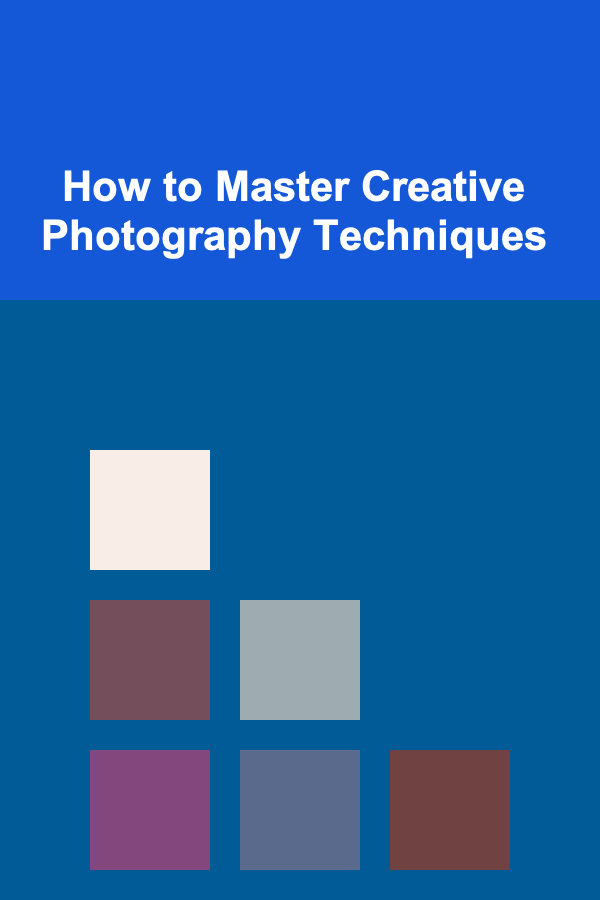
How to Master Creative Photography Techniques
ebook include PDF & Audio bundle (Micro Guide)
$12.99$9.99
Limited Time Offer! Order within the next:

Photography, in its essence, is an art form that allows us to capture moments in time and transform them into lasting memories. Whether you're a beginner or an experienced photographer, mastering creative photography techniques is essential to elevate your craft. Creative photography goes beyond just taking pictures---it involves an artistic approach to composition, lighting, angles, and storytelling. It allows photographers to express themselves uniquely, giving their images a distinct personality and emotional depth.
In this article, we will explore how to master creative photography techniques. We will cover the fundamentals, advanced techniques, and tips on how to continually improve your photography skills.
Understanding the Basics of Photography
Before diving into creative techniques, it's important to have a solid understanding of basic photography principles. These fundamentals will serve as the foundation for experimenting with more advanced creative ideas.
Exposure Triangle
One of the core concepts in photography is the exposure triangle. This refers to the three key elements that control how much light enters the camera and how that light affects your photograph:
- Aperture (f-stop): The aperture controls the amount of light entering the camera and the depth of field. A wider aperture (lower f-number) allows more light and creates a shallow depth of field, resulting in a blurred background. A narrower aperture (higher f-number) decreases the light entering the camera and increases the depth of field, keeping more of the image in focus.
- Shutter Speed: Shutter speed determines how long the camera's sensor is exposed to light. A fast shutter speed freezes motion, while a slow shutter speed can create motion blur, adding a sense of movement to an image.
- ISO: ISO controls the camera sensor's sensitivity to light. A higher ISO is useful in low-light situations, but it can introduce noise into your image. A lower ISO produces a cleaner, sharper image but requires more light to properly expose the shot.
Understanding how to balance these three elements will give you greater control over the creative possibilities of your photos.
Composition
Composition is another essential element in photography. It involves arranging visual elements in the frame to guide the viewer's eye and create a balanced and harmonious image. Several composition rules can help you create striking photographs:
- Rule of Thirds: Divide your frame into nine equal parts using two horizontal and two vertical lines. Place the subject or focal point at the intersection of these lines for a more dynamic and balanced composition.
- Leading Lines: Use natural lines (roads, rivers, pathways) to lead the viewer's eye to the subject of the photo.
- Framing: Use objects in the foreground or around the subject to frame your shot, drawing attention to the main subject.
- Symmetry and Patterns: Look for natural or architectural symmetry and repeating patterns to create visually appealing and orderly compositions.
With a strong understanding of the exposure triangle and composition, you can begin to experiment with more creative photography techniques.
Experimenting with Light and Shadows
Light is the most important tool in photography, and learning how to manipulate it can significantly enhance your creative output. By experimenting with light and shadows, you can add mood, drama, and visual interest to your photos.
Natural vs. Artificial Light
Both natural and artificial light have their own unique characteristics. Natural light is often soft and diffused, especially during the golden hour (the period just after sunrise or just before sunset). Artificial light, such as studio lighting or flash, can be harsh and direct, but it gives you more control over your lighting setup.
- Golden Hour: Take advantage of the soft, warm light during the golden hour to create photos with beautiful, flattering tones. The low angle of the sun during this time also creates long shadows and adds depth to your photos.
- Backlighting: Position your light source behind your subject to create silhouettes and dramatic lighting effects. This technique can produce striking images where the subject is outlined against a glowing background.
- Artificial Lighting: Use studio lights, flash, or light modifiers (softboxes, umbrellas) to shape the light in creative ways. Experiment with different light placements, angles, and intensities to create varied moods in your photos.
Playing with Shadows
Shadows are often an underutilized aspect of photography, but they can be incredibly powerful in creating mood and emphasizing shapes. Experiment with different light angles to cast interesting shadows and highlight textures, patterns, and forms.
- Harsh Shadows: Strong, directional light can create sharp, defined shadows that add drama and contrast to an image.
- Soft Shadows: Use diffused light (such as on cloudy days or with softboxes) to create subtle, soft shadows that lend a more ethereal or dreamy look to your photographs.
High and Low Key Lighting
- High Key Lighting: High key lighting creates a bright, clean, and airy look, often associated with portraits or product photography. It involves using soft lighting to minimize shadows and create an overall light and bright image.
- Low Key Lighting: Low key lighting creates moody, shadow-filled images with strong contrasts. It's often used for dramatic portraits or artistic shots.
Exploring Different Perspectives
Changing your perspective can completely transform an ordinary scene into something extraordinary. By adjusting your viewpoint, you can create more interesting compositions and capture scenes in new, unexpected ways.
Getting Low or High
A simple change in height can drastically alter the look of your photos. Try shooting from a low angle to emphasize foreground elements and give your subject more presence. Conversely, shooting from a high angle can give your image a sense of detachment or help you capture a broader perspective.
Wide-Angle Lenses
Wide-angle lenses allow you to capture a larger portion of the scene, often distorting the lines and shapes of your subject. When used creatively, wide-angle lenses can exaggerate perspective, making objects closer to the lens appear larger while pushing the background farther away.
Tilted or Dutch Angle
Tilting your camera (Dutch angle) can add a sense of tension, unease, or action to your shots. This technique is often used in cinematic photography to create dynamic, disorienting compositions.
Mastering Long Exposure Photography
Long exposure photography is a technique where the camera's shutter remains open for an extended period of time, capturing movement and light trails. This technique can be used to create striking, surreal images, particularly in landscapes, night photography, and urban settings.
Capturing Motion
Long exposure is particularly effective for capturing motion, such as flowing water, moving clouds, or cars' headlights at night. By using a slower shutter speed, the movement becomes blurred, resulting in a sense of fluidity and motion within the frame.
- Waterfalls and Rivers: Use a long exposure to create a silky, smooth effect on flowing water, adding a soft, ethereal quality to the image.
- Light Trails: Capture the movement of lights, such as car headlights or fireworks, to create colorful, streaking light patterns.
Using ND Filters
To achieve longer exposure times in bright daylight, you can use neutral density (ND) filters. These filters reduce the amount of light entering the camera, allowing you to use slower shutter speeds without overexposing the image.
Playing with Depth of Field
Depth of field (DOF) refers to the area of an image that is in focus. Mastering DOF can help you control how much of your image is sharp and how much is blurred, allowing you to isolate subjects or create a dreamy, abstract effect.
Shallow Depth of Field
A shallow DOF, achieved with a wide aperture (low f-number), isolates your subject from the background by blurring the surroundings. This technique is commonly used in portrait photography to emphasize the subject while creating a soft, creamy background.
Deep Depth of Field
A deep DOF, achieved with a narrow aperture (high f-number), keeps most of the image in focus. This is ideal for landscape photography, where you want to capture both the foreground and background in sharp detail.
Bokeh
Bokeh refers to the aesthetic quality of the out-of-focus areas in an image. By using a wide aperture, you can create bokeh effects that turn background lights or shapes into soft, circular blobs, adding a beautiful, artistic quality to your photographs.
Post-Processing and Editing Techniques
Post-processing is where the magic happens. Editing your photos allows you to enhance colors, adjust exposure, remove distractions, and apply creative effects that take your images to the next level.
Basic Adjustments
- Exposure and Contrast: Adjust exposure to brighten or darken your image and use contrast to enhance the difference between light and dark areas.
- White Balance: Adjust the white balance to correct color casts and ensure that the colors in your image appear natural.
Creative Editing
- Dodging and Burning: This technique involves selectively lightening (dodging) or darkening (burning) areas of the image to create depth, highlight certain elements, or add drama.
- Color Grading: Experiment with color grading to give your images a distinct mood or style. This is often used in cinematic photography to evoke a particular feeling.
- Lens Distortion and Effects: Add creative effects, such as vignettes, lens flares, or tilt-shift effects, to give your photos a unique look.
Continual Learning and Experimentation
The key to mastering creative photography is continual learning and experimentation. The more you practice, the more you will develop your unique style and understanding of different techniques. Don't be afraid to experiment with new gear, settings, and approaches to photography.
Keep Experimenting with New Ideas
Explore new genres of photography, such as street photography, astrophotography, or abstract photography. Each genre offers new challenges and opportunities for creative expression.
Seek Inspiration from Others
Look at the work of other photographers, both famous and amateur. Platforms like Instagram, Flickr, and photography blogs are great places to discover new ideas and get inspiration for your own projects.
Join Photography Communities
Engage with other photographers through online forums, social media groups, and local photography clubs. Sharing your work, receiving constructive feedback, and discussing techniques with others will help you grow as a photographer.
By understanding the basics of photography, experimenting with light, playing with perspective, and continually honing your skills through practice, you can master creative photography techniques. Photography is an ongoing journey, and with each shot you take, you'll discover new ways to express yourself through this powerful visual medium. Keep pushing the boundaries, stay curious, and let your creativity flow.

How to Build a Profitable Online Store and Make Money from Home
Read More
How to Organize Your Recipes for Quick Meal Planning
Read More
How to Pet-Proof Your Home for Puppies and Kittens
Read MoreHow to Use Expense Tracking Apps to Simplify Your Process
Read More
The Art of Mechanical Design: From Concept to Prototype
Read More
The Compliance Officer's Playbook: Best Practices for Ensuring Organizational Integrity
Read MoreOther Products

How to Build a Profitable Online Store and Make Money from Home
Read More
How to Organize Your Recipes for Quick Meal Planning
Read More
How to Pet-Proof Your Home for Puppies and Kittens
Read MoreHow to Use Expense Tracking Apps to Simplify Your Process
Read More
The Art of Mechanical Design: From Concept to Prototype
Read More